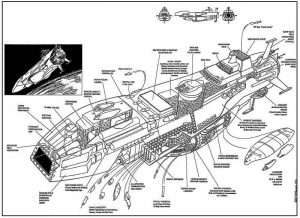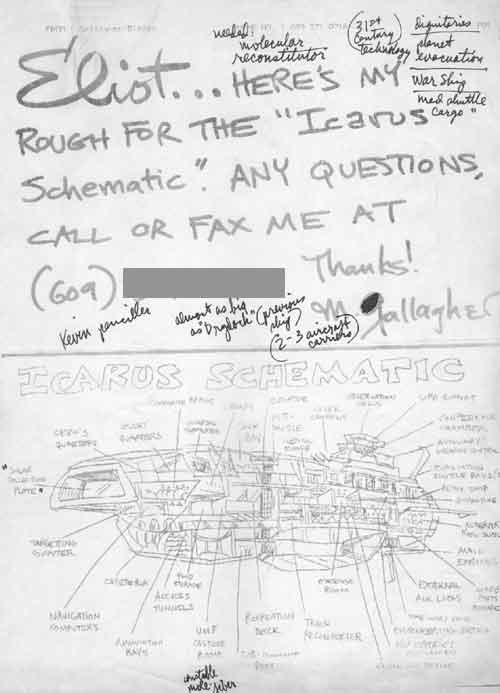The Story Behind the Guardians of the Galaxy’s
Icarus Spaceship Schematic
For the first time!
Read the technical specifications and descriptions OMITTED from the 1994 Guardians of the Galaxy Annual No. 4
I never had a great affinity for the Guardians of the Galaxy. Yet another space-faring group of super-heroes running around and doing stuff. There’s anger, yelling, hinted-at romance, doing battle, avoiding battle, etc., etc.
I think I zoned out of space-faring super-heroes when Chris Claremont had the X-Men hook up with the Shi-Ar . . . Then Bill Mantlo took a hand-axe to old pirate stories with his Swords of the Swashbucklers. By then I was propping my eyes open with toothpicks. Whoo boy.
But when Marvel Comics editor, Craig Anderson called for me to do the Guardians of the Galaxy’s big ole spaceship, Icarus, I said, “You betcha!” You see, 1994 was a dark year for this comic book professional. The comic book biz was sinking and no one knew why. (If you want a better idea, read Comic Wars by Dan Raviv Hardcover: 320 pages, ISBN 0-7679-0830-9. This is a terrific account of much of what went wrong. Us poor bums doing the work had very little idea so much was going sour around us.
I started by learning about the good ship Icarus. I was put in touch with the very nice comic book creator, Kevin West, and we yakked up a storm. I got what I needed from him and then I was put in touch with Michael Gallagher, another very accommodating comic book creator. Between these two guys, I had little to do in terms of searching for reference! They very kindly sent me their concept ideas and sketches and some good reference from the books. When you need to know something about a comic book the pencilers are the guys to seek. They have to know even more than the writer, as it is they who add the visual twists that place the story in “a” reality for the reader/viewer.
So, why am I writing about this middle-of-the-road team and their spaceship?
Because each of my complicated “tech” pages is a home run for me. An over-the-horizon, air-traffic-controller-alert home run. Each ship, each headquarters page, is a stand-alone beast of varying complexity which takes days of design and penciling and then days or weeks of inking and finishing and writing.
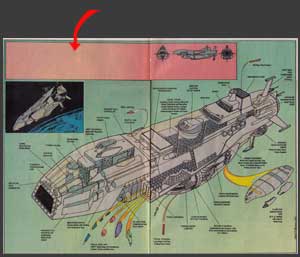
And because the Guardians of the Galaxy 1994 Annual No. 4 is the only comic book that contains a work of mine that was printed in a severely compromised fashion.
Now there is enough of the “call out” labeling done, so that readers may not have expected any more. But there is that gaping, yawning acre of empty space that tells a different story.
But before this perfidy occurred, Kevin, Mike and I were gamboling happily along. See below? Happy and unsuspecting . . .
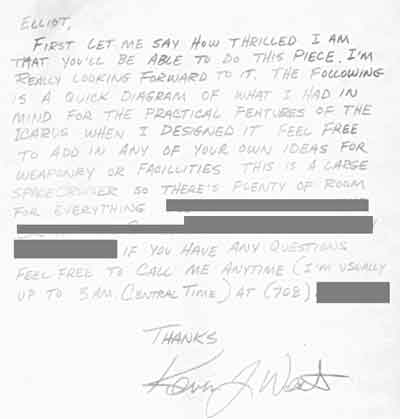
Kevin West wrote, “First let me say how thrilled I am that you’ll be able to do this piece. I’m really looking forward to it. The following is a quick diagram of what I had in mind for the practical features of the Icarus when I designed it. Feel free to add any of your own ideas for weaponry or facilities. This is a large spacecruiser so there’s plenty of room for everything.” Kevin, who was as gracious as one could hope for, provided me with as much time as was needed to get all the details right. Michael Gallagher also started me off with reference and sketches.
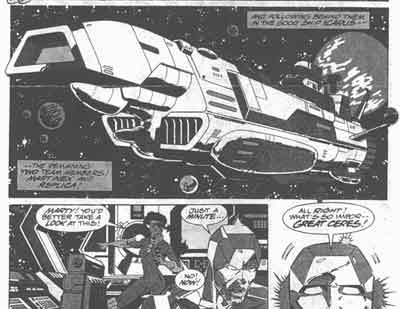
Great Ceres, indeed! So there’s a good look at the Icarus.
The above sketch of the Icarus, the Guardians of the Galaxy Spaceship, came from Michael Gallagher. I found this angle was not sufficient to allow one to see far enough “into” the ship. With a ship as large as this, scale and what you could reasonably expect to see plays a big role in how lazy I can be. The more you can show, the more details you have to draw. When you can get down to seeing door-knobs, for example, you have to draw thresholds, hinges, door mats — well, you get the idea.
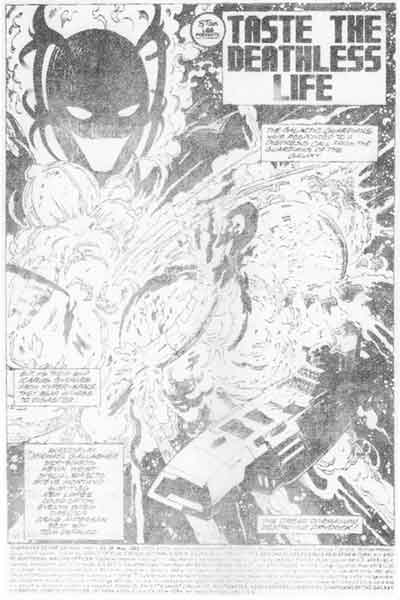
The splash page above is the Guardian of the Galaxy’s old ship, Drydock, getting turned into space dust. This is from Guardians of the Galaxy Vol 1 No. 26, May 1993. A nice reference picture.
The sketch below of the Icarus, the Guardians of the Galaxy Spaceship, is from Kevin West, showing slightly better proportions. I liked a leaner ship. Sure, we all know that spaceships can look like flying office buildings, but it’s harder to hear them go “whoosh” that way. The pointy end goes thataway.
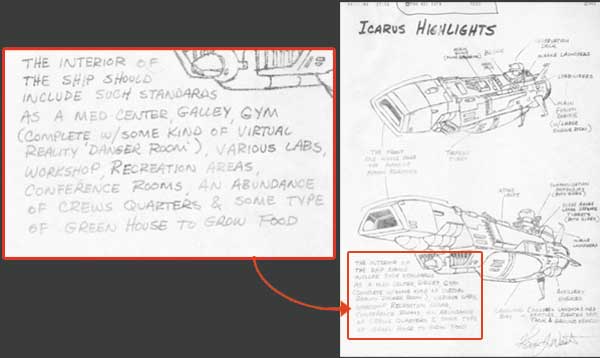
Kevin West wrote, “The interior of the ship should include such standards as a med center, galley, gym (complete w/some kind of “virtual reality” danger room), various labs, workshop, recreation areas, conference rooms, an abundance of crew quarters & some type of green house to grow food.”
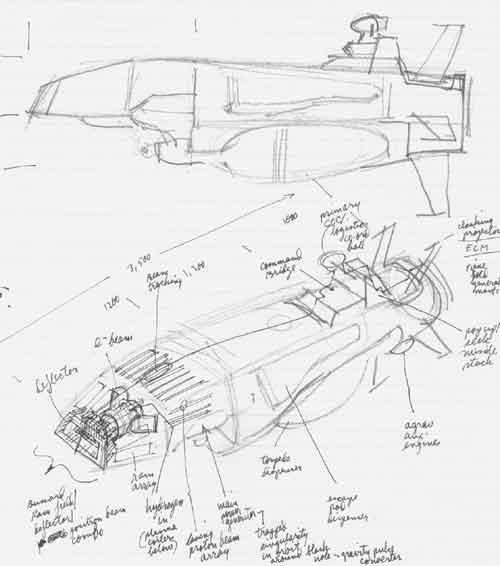
At right is my first sketch of the Icarus, the Guardians of the Galaxy Spaceship. This was the angle I liked and stuck with. I had heard a little bit about Prof. Bussard’s ram scoop concept. Of course, I had read all about it in early
But the idea that gigantic magnetic fields could be set up in a fan-shaped scoop pattern to guide in hydrogen atoms — located liberally throughout inter‑stellar space — and shove them into a fusion reactor to generate electricity was a totally real one. Who knows? They may happen some distant day. In the meantime, I had to switch the techno-babble generator to “overload” for this ship.
One thing I’d like to point out are those skinny, antennae-like masts sticking off the back end. There’s something about the Japanese and these things. There was a pretty cool Japanese anime movie that started a whole lot of space hardware on its way. But they had these kooky mast things sticking off them. What did they do? For me, it was what could they do! (They could put your eye out!) So you may note that my comrades-in-art shied away from explaining these things. But me? I waded in and labeled them, uhh, several things. I eventually settled on “Warp Wave Field Conditioner.” Yep, that’s right.
1994, the year this work was rendered and printed, was not long enough after for people to completely forget it. The look of the Icarus was clearly influenced by the shape of the Battlestar Galactica. The look of Galactica was okay — not bad for 1978! Now a lot of people hold that show up as a high water mark of sci-fi brilliance. But it was producer Glen Larsen capitalizing on Star Wars and demonstrating how “economical” TV could be with using footage over and over again.
Usually I am stuck with whatever oddball shape the comic book creators — to be fair — either spat out or labored mightily over. When I got to do something on my own, like with this piece, I could have some fun. I figured there would be a variety of shapes and in that way, perhaps a variety of ways to suggest that they were designed by engineers of different world races. I thought it would be fun to show just how big this thing was by showing how many other ships it carried. I finally got to design something for myself.
Then came the writing part. I was particularly proud of the serious foundations I had laid down. The highest high-technology I could come up with — this was in the days before “nanotechnology” was a part of everybody’s toothpaste! The entire hull was made out of carbon-60, which was brand new (as a discovery) back then. No one knew that it couldn’t be made into a super hull! I was really hoping to introduce new ideas to the series, suggest potential for the writers . . . Let’s just say I worked really hard on the copy.
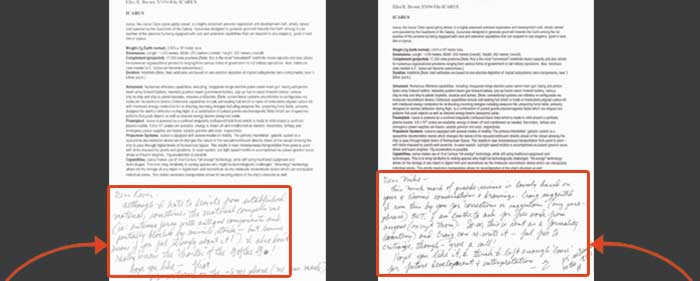
Dear Kevin —
Although I hate to deviate from established material, sometimes the material compels me (ie: antenna farm with antique components and partially blocked by missile stack — but lemme know if you feel strongly about it!) I also don’t really know the charter of the G of the G!
Hope you like — Eliot
Dear Mike —
This mish mash of pseudo-science is loosely based on your and Kevin’s conversations & drawings. Craig suggested I run this by you for “corrections or suggestions” (my paraphrase) BUT, I am loathe to ask for free work from anyone (except Mom). So-oo, this is sent as a formality courtesy and Craig can re-write it — feel free to criticize, though — give a call!
Hope you like it, I think I left enough ‘loose’ for future development and interpretation.
— E
Above you see one version of the text, faxed to Kevin West for his perusal, and also one faxed to Mike Gallagher so that he can see all the work I was so proud of . . .
Remember that this was 1994. This is before the Marvel Comics editors and creators were connected by e-mail and before comic book publishing went digital. Type had to be printed out and pasted on to the board. My wife Arlene and I had been running out our own type for the Punisher Armory for a couple of years and we also output and pasted down the type for the Icarus “call outs.” But we didn’t have the equipment to clearly print out the small type the copy text required. So I printed out the copy for Marvel Comics editor Craig Anderson to show the Bullpen and I copied the text on to a diskette so that some poor devil of a typesetter wouldn’t have to re-key the whole thing. With a smile on my lips and a song in my heart, I traveled in to Marvel to deliver the art and copy.
Craig and Lyn (Marvel Comics Assistant Editor, Lynair Brust), accepted my pages with the reverent silence they deserved. Craig looked on with either that face that says, “your words are golden to me, man” or a prolonged “Duuuuuuuuuhhhhhh . . . ” We all agreed that the Bullpen would output the high-resolution type and paste it down to the board. Then I gave that stolid, chipper little smile that says, “I just handed in a job well done.” Yep. I skipped down the hall, almost singing. The high is that intense; yes.

Three months later, I saw the printed book and it looked like this:
I thought, “Finally comic book madness has claimed me.” I look but I do not see. Where is my super special hard-work text? Of course it’s there, I must have just developed hysterical blindness is all . . . How could this have happened?
When I next got into the office and asked what had happened, Craig gave me one of those, “Gosh I tried,” looks and flapped his hands in a helpless fashion. Something about not being able to find the copy or having the time to do it (I was on time for a change). Something else about how these things will happen in a monthly. Craig then gave me what was intended to be an, “Aw, shucks,” sort of half-smile. The sort of self-forgiving smile one sees on politicians and car dealers. I sputtered but mostly recall backing out of the room. I crawled off in a daze; it’s for times like that that I wish I were a drinking man. I would have crawled into a bottle.
With the usual helplessness that any freelancer lives under, I could only suggest a fix and faxed this in:
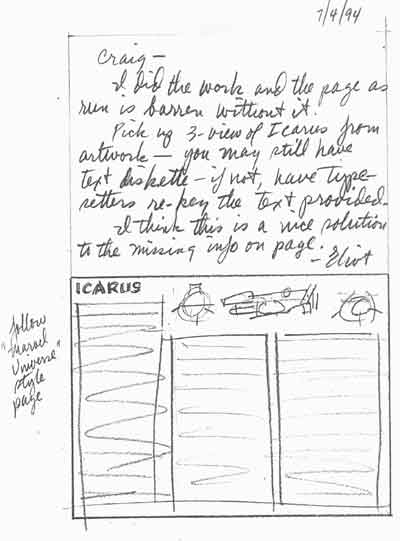
But this too, no doubt, slid off the teetering pile of offal on Craig’s desk and joined the fetid, greasy pile of junk on the floor . . . Many years later, the sting is still fresh. The disappointment still sharp.
For now, I can only right this wrong by running the text that should have appeared all those years ago. Here then, are the specifications and descriptions of The Guardians of the Galaxy’s universe-spanning ship, Icarus!
ICUARUS
Icarus, the Icarus Class space‑going vessel, is a highly advanced universe exploration and development craft, wholly owned and operated by the Guardians of the Galaxy. Icarus was designed to generate good will towards the Earth among the far reaches of the universe by being equipped with vast and extensive capabilities that can respond to any exigency, good or bad; dire or joyous.
Armament: Numerous offensive capabilities, including: megajoule‑range electron pulse canon main gun; lasing anti‑proton beam array forward battery; steerable positron beam gun forward battery; pop‑up fusion canon forward battery; various ship‑to‑ship and ship‑to‑planet torpedoes, missiles and bombs. [Note; conventional systems are infinitely re‑configurable via molecular reconstitutor device.] Defensive capabilities include a self‑sealing hull which is made of molecularly‑aligned carbon‑60 with interfaced energy conductors for re‑directing incoming energies including weapons fire; projecting force fields, primarily designed for detritus deflection during flight, is a combination of pulsed gravito‑electromagnetic fields which are shaped into patterns that push objects as well as directed energy beams (weapons) aside.
Powerplant: Icarus is powered by a confined singularity (collapsed black hole) which is made to orbit around a synthetic plasma bubble. 9.8 x lO15 joules are available; energy is drawn off and conditioned as needed. Secondary, tertiary and emergency power supplies are fission, astable graviton and solar, respectively.
Propulsion Systems: Icarus is equipped with several modes of motility. The primary interstellar‑galactic system is a space/time disorientation device which changes the nature of the vacuum continuum directly ahead of the vessel allowing the ship to pass through higher levels of Reimannian Space. This results in near instantaneous transportation from point to point — with limits imposed by gravity well proximity. In‑solar‑system, sub‑light speed motility is accomplished via pulsed graviton wave drives and fusion engines; 15g acceleration is possible.
Capabilities: Icarus makes use of 31st Century “all‑energy” technology, while still using traditional equipment and technologies. This is to bring familiarity to visiting species who might be technologically challenged. “All‑energy” technology allows for the storage of any object in digital form and reconstitute via the molecular reconstitutor device which can manipulate individual atoms. This atomic‑resolution manipulation allows for reconfiguration of the ship’s structure as well.
